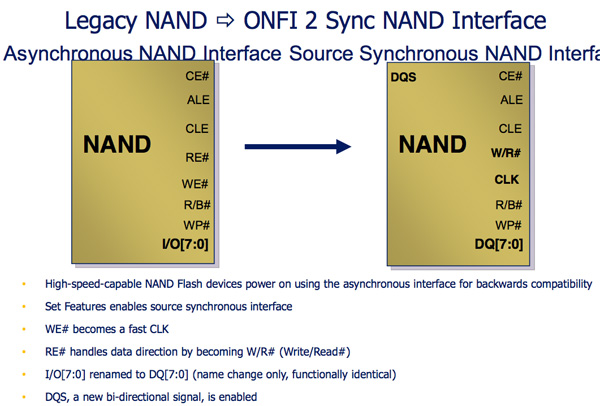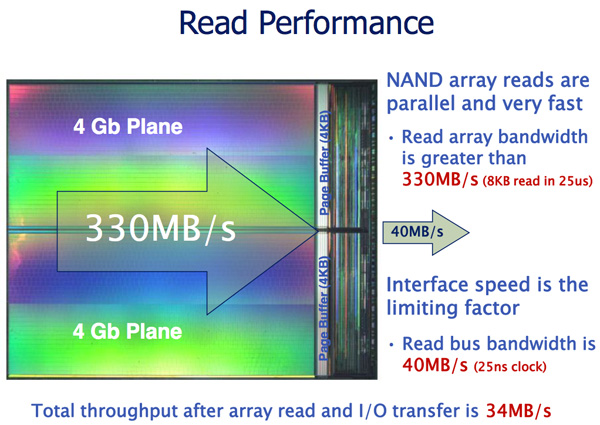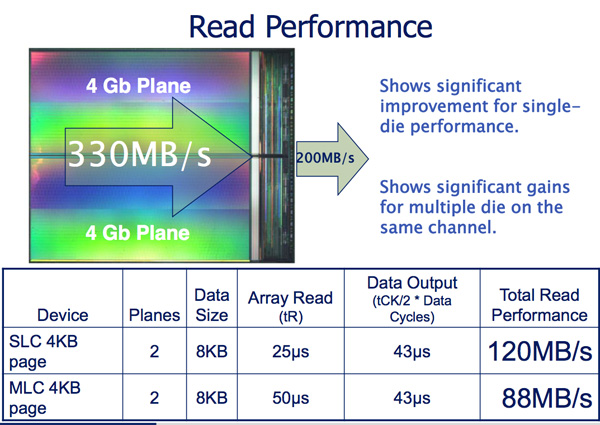SandForce Announces Next-Gen SSDs, SF-2000 Capable of 500MB/s and 60K IOPS
by Anand Lal Shimpi on October 7, 2010 9:30 AM ESTNAND Support: Everything
The SF-2000 controllers are NAND manufacturer agnostic. Both ONFI 2 and toggle interfaces are supported. Let’s talk about what this means.
Legacy NAND is written in a very straight forward manner. A write enable signal is sent to the NAND, once the WE signal is high data can latch to the NAND.
Both ONFI 2 and Toggle NAND add another bit to the NAND interface: the DQS signal. The Write Enable signal is still present but it’s now only used for latching commands and addresses, DQS is used for data transfers. Instead of only transferring data when the DQS signal is high, ONFI2 and Toggle NAND support transferring data on both the rising and falling edges of the DQS signal. This should sound a lot like DDR to you, because it is.

The benefit is tremendous. Whereas the current interface to NAND is limited to 40MB/s per device, ONFI 2 and Toggle increase that to 166MB/s per device.

Micron indicates that a dual plane NAND array can be read from at up to 330MB/s and written to at 33MB/s. By implementing an ONFI 2 and Toggle compliant interface, SandForce immediately gets a huge boost in potential performance. Now it’s just a matter of managing it all.
The controller accommodates the faster NAND interface by supporting more active NAND die concurrently. The SF-2000 controllers can activate twice as many die in parallel compared to the SF-1200/1500. This should result in some pretty hefty performance gains as you’ll soon see. The controller is physically faster and has more internal memory/larger buffers in order to enable the higher expected bandwidths.

Initial designs will be based on 34nm eMLC from Micron and 32nm eMLC from Toshiba. The controller does support 25nm NAND as well, so we’ll see a transition there when the yields are high enough. Note that SandForce, like Intel, will be using enterprise grade MLC instead of SLC for the server market. The demand pretty much requires it and luckily, with a good enough controller and NAND, eMLC looks like it may be able to handle a server workload.










84 Comments
View All Comments
tipoo - Thursday, October 7, 2010 - link
...Isn't going to stay relevant long, is it? Already up to 500MB/s SSD's, and SATA 3 isn't even mainstream yet. Its going to become a bottleneck soon, just like SATA II is for current SSD's.rundll - Thursday, October 7, 2010 - link
Well, OCZ introduced few days back a new data link interface HSDL to handle Sata bottlenecks. Let's see what this means in real life.aguilpa1 - Thursday, October 7, 2010 - link
Break out your piggy banks if this is the wavejonup - Thursday, October 7, 2010 - link
They are a private company. As Anand said, a success of the new controller might force them in an IPOiwodo - Thursday, October 7, 2010 - link
Can we plug 2 SATA 6Gbps into a Single 2.5" SSD? We manage to max out SATA 3.0 in one go, and it is SATA 3.0 not even widely available yet.I hope the there would be at least some minor improvement in their DuraWrite and other part of the controller. Otherwise it looks like an overclocked Sandforce with better NAND interface to me.
Firmware should be less of an issues, since it is similar to older chips, the firmware should be stable enough.
Cant wait......
rundll - Thursday, October 7, 2010 - link
"...Otherwise it looks like an overclocked Sandforce with better NAND interface to me"Did we read the same article?
nexox - Thursday, October 7, 2010 - link
Ehh, you know 12Gbit SATA/SAS is due out in 2012, right? That's about in time for Sandforce's 3rd gen controller.And just because they've managed to double their bandwidth with this generation doesn't mean they've still got another trick up their sleeves to double their bandwidth again for the rev after this one.
Iketh - Thursday, October 7, 2010 - link
we're not talking physical limitations of a head moving back and forth on a spinning disk.... doubling performance at the least is much more the norm in the realm of silicon, nothing remotely close to a "trick" about itsoftdrinkviking - Friday, October 8, 2010 - link
I hope we get light peak before that; I just like the idea of my data flashing around through my pc in bursts of light. It's all so very "future is now."iwodo - Saturday, October 9, 2010 - link
No Trick, DDR NAND @ 133Mbps x 8 Channel already gives you just over 1Gbps SSD.And that is with CURRENT tech, the best thing about SSD is that it is easily scalable. You could do 10 Channel like Intel, ( Expensive ), or 16 Channel for total bandwidth since you get 16 Chips on a SSD.
You could also speed up NAND with DDR tech or small node but higher clockspeed.
The only limitation is how fast the controller could work. Which we still have much headroom.